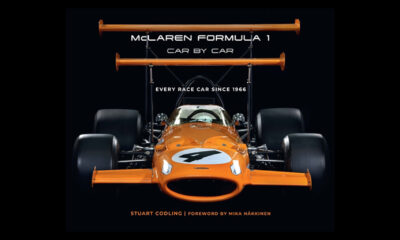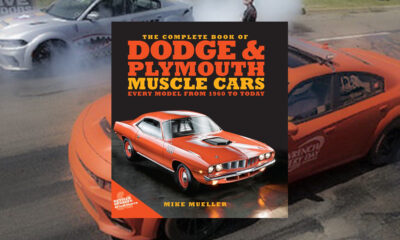Book Review
Tyrrell: The Story of the Tyrrell Racing Organisation – DRIVEN TO SUCCEED
Tyrrell: The Story of the Tyrrell Racing Organisation
DRIVEN TO SUCCEED
Some of my best automotive moments have taken place in a movie theater, beginning with director John Frankenheimer’s Grand Prix in the mid-‘60s, continuing with Steve McQueen’s signature take on endurance racing with Le Mans, Ron Howard’s look at the James Hunt/Niki Lauda rivalry in Rush, and the most recently released, director Neill Blomkamp’s Gran Turismo. Beginning next week, I’ll find myself immersed in Michael Mann’s Ferrari, starring Adam (and this is perfect!) Driver. Following those two hours I’ll return to a semblance of normality with Richard Jenkins’ exhaustive (but not exhausting) look at team owner and manager Ken Tyrrell in TYRRELL – THE STORY OF THE TYRRELL RACING ORGANISATION.
If Enzo Ferrari, based largely on both his public persona and private machinations, impresses as The Godfather, and Carroll Shelby is a mechanized John Wayne, Ken Tyrrell could be seen as a British take on Earl Hamner Jr.’s John Walton. In postwar Britain Ken and his half-brother, Bert, started (and to be clear, they self-started) hauling timber, which led to buying and selling lumber. That enterprise proved sufficiently lucrative for Tyrrell to tip-toe into racing, first entering himself in races – beginning in the early ‘50s – and subsequently identifying drivers to pilot those cars owned and managed by his always-small organization.
From those very humble beginnings, beginning with a Cooper 500 and progressing through Formula Junior, Formula 3 and Formula 2, Tyrrell built a race team that literally kicked ass on Formula One grids, beginning in the late ‘60s and continuing well into the ‘70s.
Of course, I spent more time rifling the pages of Road & Track than sitting in those theaters, and the reporting of Henry Manney on Formula 1 racing in Europe inevitably included Lotus and Brabham in the middle of the ‘60s (both Brabham and Lotus had also made their marks at Indy in the first half of that decade), while it would be all Tyrrell as the ‘60s wound down, winning – with driver Jackie Stewart – the Formula 1 World Championship in 1969, 1971 and 1973.
In its 464 pages and with over 450 images, reading Jenkins’ book takes a level of commitment, but his audience is rewarded by an intimate look at both the boldface talent on the grid, as well as many of the personnel working 24/7 (long before that descriptive was common) necessary to the success on the grid. As a private entrant in an era that preceded Formula 1’s commercialism, teams competed for little more than appearance fees and race winnings. Tyrrell captained an impossibly frugal ship, and found a means of getting to the podium when much more substantial teams failed to win, and often failed to finish.
Of course, what goes up inevitably comes down, and so it was with Tyrrell. As the ‘80s and ‘90s became increasingly complex, the technology absorbed budgets the smaller teams – such as Tyrrell’s – simply couldn’t muster. Whether it was powertrain partnerships without the necessary power, or lack of appropriate monies for competitive testing, the environment simply proved too taxing for the privateer, and was something even Ken Tyrrell couldn’t work around. The end came after the ’97 season, when the Tyrrell organization was acquired by British American Racing, funded by British American Tobacco. By ’99 Ken Tyrrell was completely removed from Formula 1, and he passed in 2001.
If born too late to have paid attention in the ‘60s, but can enjoy the aesthetic beauty of the single seater at what many regard as the height of its evolution, than the Tyrrell volume’s collection of period images is alone worth the $120 price of admission. I especially like the evolution of the mid-engine layouts, beginning in the early ‘60s with Cooper and Lotus, as well as later in the decade with the Tyrrell team’s alliance with French constructor Matra.
If there’s one complaint when considering another large book – even one that’s beautifully executed – it’s this: With each new coffee table book I feel the need to acquire an all-new coffee table. That, of course, can get expensive…



























